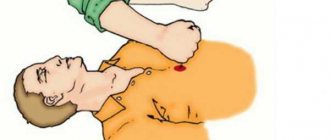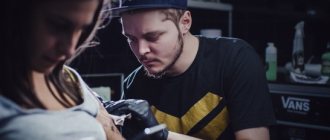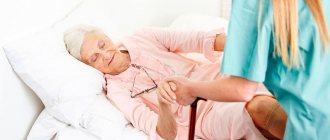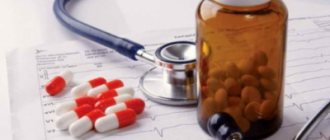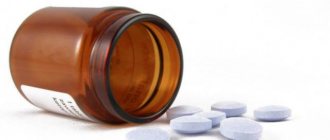Risk factors
Nonmodifiable risk factors for stroke include older age, male gender, prematurity and malnutrition (low birth weight), and genetic predisposition. It is impossible to influence these reasons, but taking them into account helps to identify a group of people who are indicated for a complete examination of the cerebral vessels. It is carried out at least once every three years, even in the absence of neurological symptoms.
Modifiable causes of cerebral blood flow disorders include:
- arterial hypertension;
- nicotine and alcohol addiction;
- excess cholesterol in the blood;
- diabetes;
- angina pectoris, atrial fibrillation, narrowing of the carotid arteries;
- violation of the structure of hemoglobin (sickle cell deformation of erythrocytes);
- using hormone replacement therapy during menopause or taking birth control medications;
- systematic neglect of nutritional rules;
- low level of physical activity;
- obesity.
Angina pectoris is one of the causes of stroke.
Every patient who has any of these factors is at increased risk, but if there are two or more, then the danger increases exponentially.
We recommend reading the article about the dangers of atrial fibrillation. From it you will learn about the causes of pathology and its consequences, the prescription of anticoagulants and other methods of prevention. And here is more information about atherosclerosis of the heart vessels.
Further treatment
After successful resuscitation measures, the patient is transferred to the neurological department, where treatment is continued with the aim of:
- improve microcirculation of brain vessels;
- prevent neuronal hypoxia;
- reduce A/D;
- reduce cholesterol levels;
- reduce thrombosis;
- stabilize the nervous and mental state;
- prevent constipation.
For hemorrhagic stroke, medications are prescribed to stop bleeding. Vasodilators and anticoagulants (thrombolytics) are prohibited.
When the patient’s condition stabilizes, he is transferred to home treatment, where he continues to take medications and undergoes a course of long-term rehabilitation.
Primary prevention of stroke in women and men
To prevent cerebral ischemia or hemorrhage, correction of modifiable causes is required. At the same time, lifestyle changes can completely eliminate the main damaging factors and significantly reduce the risk of stroke.
Partial success can be achieved by compensating for the main manifestations of diseases (diabetes, hypertension, cardiac pathology).
Lifestyle
Smoking leads to persistent spasm of the arteries and progression of sclerotic changes. Such disorders are irreversible over time, so all patients with this or another risk factor are recommended to quit smoking to preserve life and work ability. It has been proven that 2 years after a person quits smoking, his blood vessels are restored, and the chances of developing a stroke are equal to non-smokers.
To treat nicotine addiction, coding, psychotherapy sessions and the following drugs are used:
- nicotine patches, chewing gum or lozenges, inhalers - Nicorette, Nicoderm, Nicotrol;
- nicotine receptor blockers - Champix, Tabex;
- antidepressants - Aventil, Wellbutrin.
Diseases such as excess cholesterol in the blood, impaired carbohydrate metabolism, and obesity are associated with poor nutrition. They can also be corrected with medications, but without following a diet, the effectiveness of medications is extremely low.
A diet that reduces the likelihood of stroke is based on the following principles:
- reduction of table salt, animal saturated fats, simple carbohydrates (sugar and flour);
- high content of fresh vegetables, berries and fruits, dairy products and low-fat fish.
Low activity during the day leads to slow blood flow and lowers the level of metabolic processes. Preventive physical activity is considered to be 30 minutes a day, five days a week, or an hour and a half for 7 days with increased intensity of exercise.
To improve training tolerance, the following may be recommended:
- Riboxin;
- vitamin complexes (Vitrum Energy, Supradin);
- L-carnitine;
- Glutamic acid;
- plant adaptogens – ginseng, leuzea, eleutherococcus.
Drinking alcohol becomes especially dangerous if you regularly exceed the permissible dose and use surrogate drinks. The risk increases in the presence of concomitant pathologies of the liver and kidneys, which inhibit its inactivation and elimination. The maximum dose for men is considered to be 30 g in terms of ethyl, no more than 4 times a week. For women it should be halved. Medicines that reduce craving for alcohol:
- cause disgust - Esperal, Teturam, Colme, Lidevin;
- reduce the desire to drink - Proproten, Vivitrol;
- relieve hangover - Medichronal, Citrarginine, Zorex, Glycine.
Drug support for chronic diseases
Hypertension occupies a dominant position among risk factors. A dangerous level of pressure starts at 140/90 mmHg. Art., with kidney disease and diabetes mellitus it is 10 units lower.
To reduce indicators, lifestyle correction and the following groups of drugs are required:
- diuretics – Arifon, Trifas;
- alpha blockers – Doxazosin, Ebrantil;
- beta blockers – Concor, Nebilet;
- calcium channel blockers – Corinfar, Lerkamen;
- angiotensin converting enzyme inhibitors – Enap, Prestarium;
- angiotensin blockers – Lorista, Micardis;
- central action - Methyldopa, Estulik, Physiotens.
To compensate for diabetes mellitus, therapy with insulin or tablets (depending on the type) is prescribed. Stroke prevention is carried out with the help of antihypertensive drugs (Lisinopril, Rami Sandoz), statins (Liprimar, Rozart) or fibrates (Traykor), Aspirin.
Excess cholesterol in the blood (dyslipidemia) is treated with dietary nutrition and the prescription of medications of the following groups:
- statins – Vazilip, Roxera;
- fibrates – Lipofen;
- combined - Ineji, Kaduet.
If the main drugs fail to achieve the desired cholesterol level, then bile acid sequestrants (cholestipol), nicotinic acid, and ezetimibe can be prescribed.
Primary prevention for heart disease is carried out with the following drugs:
- for heart defects, angina pectoris and heart attack - Warfarin;
- atrial fibrillation - Aspirin, Clopidogrel and Warfarin;
- carotid artery stenosis - surgical treatment and subsequent administration of Aspirin.
Sickle cell anemia is treated with blood transfusions, red blood cells, and hydroxyurea. For replacement therapy during menopause in patients at risk, progestins and estrogens are not used; Premarin is especially harmful.
The use of tablet contraceptives increases the risk of stroke due to additional factors (smoking, excess weight). Therefore, they are prescribed together with anticoagulants or another method of protection is chosen.
Weight loss for obesity involves a hypocaloric diet and dosed physical activity; drug therapy can be used only if other measures are ineffective (Xenical, Meridia).
Watch the video about stroke prevention methods:
Secondary prevention of stroke
The likelihood of a recurrent stroke decreases if all modifiable risk factors are eliminated or their symptoms are compensated as much as possible. Regular monitoring of patients' condition and preventive drug courses also help prevent relapse.
General examination methods
After a stroke, patients are under the supervision of a neurologist, and for concomitant diseases, consultations with an endocrinologist, cardiologist, or vascular surgeon are indicated. Mandatory examinations include:
- general blood test, lipid profile, coagulogram;
- blood sugar, if it increases, glucose tolerance test, glycated hemoglobin;
- Ultrasound of the vessels of the neck and head in duplex scanning mode;
- ECG, including with functional tests;
- MRI or CT scan of the brain;
- cerebral angiography for suspected (dynamic observation) of dissection of the walls of the carotid arteries, aneurysm, malformation, fibromuscular dysplasia, arteritis or Moyamoya disease.
For an in-depth study of cardiac risk factors, the study can be supplemented with:
- Ultrasound and chest x-ray;
- ECG monitoring according to Holter;
- blood test for antiphospholipid antibodies.
Additional after hemorrhagic and ischemic stroke
The main attention after acute cerebral ischemia is aimed at identifying atherosclerotic changes in the vascular bed, therefore studies of the coronary vessels, renal arteries, lower extremities, as well as dynamic monitoring of the indicators of the coagulation system and lipid spectrum are indicated. For this purpose, the methods of echography, rheovasography, capillaroscopy, and angiography are used. The use of functional diagnostic tests is shown.
After a cerebral hemorrhage (hemorrhagic stroke), the main direction for diagnosis is monitoring blood pressure levels, ECG, examination of the fundus vessels, repeated tomography is indicated to monitor the state of cerebral hemodynamics.
Primary support medications
To restore basic brain functions and prevent the spread of the damaged area, complex therapy is used. Main groups of drugs:
- neurotrophic (indicated for speech disorders, cognitive dysfunction, low level of mental activity) - Cerebrolysin, Actovegin, Mexicor, Cytoflavin, Semax;
- to improve cerebral blood flow - Cavinton, Agapurin, Bilobil;
- nootropic – Ceraxon, Piracetam, Phenotropil;
- for vascular dementia - Mema, Gliatilin, Neuromidin;
- to relieve attacks of dizziness - Betagis;
- for spastic muscle conditions - Baclofen, Sirdalud;
- antidepressants – Prozac, Anafranil, Tsipramil.
Drugs and tablets to prevent recurrent stroke
The program of measures for secondary prevention of relapse of acute disorders of cerebral hemodynamics includes the following areas:
- stabilization of blood pressure (130 - 140/80 - 90 mm Hg) - ACE inhibitors (Captopril, Hartil) and diuretics (Hypothiazide, Tifas);
- antithrombotic therapy - Warfarin, Ipaton, Plavix, Aspirin;
- with low coagulation activity (prevention of hemorrhage) - Dicynon, Trenaxa;
- lowering blood cholesterol - diet, statins (Roxera, Zocor).
If necessary, drug therapy is supplemented with surgical therapy; carotid endarterectomy is indicated for obstruction of the carotid arteries.
To prevent cerebral blood flow disorders, it is necessary to identify risk factors as early as possible and minimize their manifestations. To do this, patients who are at risk of vascular crises must be fully examined, they are recommended to adjust their lifestyle, diet, increase physical activity, give up bad habits and undergo courses of drug treatment.
Kinds
For reference. Repeated stroke is of two types: ischemic (4/5) and hemorrhagic (1/5), which is much more severe, ending in death in 80% of cases.
Often the primary stroke is ischemic, and the second time is hemorrhagic. Or vice versa. The same affected areas and brain structures are affected, but the pathogenesis is different.
Repeated ischemic stroke is divided into local and extensive.
Local often begins suddenly, the lesion is unilateral. The severity is determined by the location and area of the necrotic area, complications after the first attack. Neurological abnormalities of moderate severity.
With a major stroke, symptoms increase gradually. Consciousness is disabled, deep neurological disorders. Basically, this species ends in death.
Signs of a recurrent hemorrhagic stroke depend on the area of the lesion.
Cortical is the heaviest type. Consciousness is grossly impaired. Severe speech disorders, paralysis, and anesthesia are observed.
What to do to avoid a stroke
To prevent a stroke, you must:
- change your lifestyle (quit smoking, alcohol, get enough sleep, avoid stress);
- proper nutrition (reduce animal fats, salt, sugar);
- control blood pressure, cholesterol and glucose levels in the blood.
These activities relate to primary prevention. After a stroke you need medications:
| Group of drugs | Titles |
| Cholesterol-lowering | Zokor, Atokor |
| Blood thinners | Plavix, Aspirin Cardio |
| Improves cerebral blood flow | Somazina, Tanakan, Glycine |
Stroke Prevention
Stroke prevention is primary – to prevent its development. It is aimed at the main risk factors (smoking, excess fat in the diet, hypertension, diabetes, obesity). Secondary prevention helps to avoid a recurrent stroke: the use of medications to normalize blood pressure, blood circulation in the brain, and thin the blood.
Primary prevention of cerebral stroke in women and men
Primary prevention of cerebral stroke for women and men includes:
- quitting smoking, which narrows the arteries and impairs blood flow to the brain tissue; for this purpose, coding and medications are used (Nicorette, Champix);
- proper nutrition - reducing the consumption of fatty meat, table salt and sugar, increasing the intake of fresh vegetables, berries, fruits, fermented milk drinks, whole grain cereals and bread, fish;
- daily physical activity for at least 30 minutes - walking, swimming, gymnastics;
- giving up alcohol or switching to the permissible dose of 15 g of ethanol for women and 30 g for men no more than 4 times a week (approximately 100-200 ml of dry red wine every other day);
- reducing excess body weight with a low-calorie diet and increasing physical activity; if effectiveness is low, Xenical, Meridia are added or surgical treatment is prescribed;
- normalization of blood pressure - reducing salt, strong tea and coffee for hypertension, taking tablets (Arifon, Prestarium, Nebilet, Lorista), it is necessary to maintain values no higher than 140/90 mm Hg. Art., avoid a sharp decrease.
With high levels of cholesterol and sugar, more stringent restrictions on their intake from food and the use of drugs to normalize blood levels are needed. Since the formation of blood clots occurs with increased blood viscosity and impaired heart function, long-term use of anticoagulants - Warfarin, Plavix, Cardiomagnyl - is recommended for patients after a heart attack with atrial fibrillation. They also help prevent ischemic stroke.
Secondary according to an individualized program
Secondary prevention is to prevent recurrent stroke, so it is individualized - a different program is needed for ischemic and hemorrhagic. It also takes into account all risk factors (smoking, alcohol, obesity, hypertension, diabetes, heart disease), age, and concomitant pathologies.
After an acute circulatory disorder due to blockage of an artery (cerebral ischemia), it is necessary:
- take blood thinners: for atrial fibrillation - Warfarin, extra-cardiac source of thrombus (atherosclerosis) - Cardiomagnyl, Curantil, Plavix;
- reduce cholesterol, prevent low-density lipoprotein levels from increasing to 3 mmol/l using diet and statins (Liprimar, Atorvastatin);
- maintain blood pressure at 130-140/85-90 mm Hg. Art., monitor indicators daily;
- Regularly (at least once every 3 months) undergo examination by a neurologist, and, if necessary, an ophthalmologist, cardiologist and endocrinologist, ECG, vascular ultrasound, general blood tests, coagulogram, lipid profile.
After a cerebral hemorrhage, secondary prevention includes:
- constant monitoring of blood pressure and taking medications that prevent its increase (Prenesa, Nimotop);
- diagnostics - repeated tomography to study residual effects, EEG, fundus examination;
- treatment of diseases that can cause increased blood pressure - diabetes, pathologies of the adrenal glands, kidneys, thyroid gland, atherosclerosis;
- complete cessation of smoking and alcohol.
Pathogenesis
In the development of secondary ischemic stroke, the main role is played by vascular lesions in the area:
- extracranial – atherosclerosis of the main arteries (usually the carotid) before they enter the cranial cavity (40% of cases);
- brain – intracerebral small arteries (35%);
- cardiac - formation of an air or fat embolus in the left ventricle and subsequent blockage of the middle cerebral artery (15 - 20%).
Vascular lesions leading to cessation of blood flow are represented by:
- blockage of the lumen of the vessel with an embolus;
- thickening of the wall due to the deposition of cholesterol plaques on it.
In the first minutes and hours, rapid necrotization of neurons occurs, caused by a pathological chain: -> blockage of the artery -> cessation of blood flow -> hypoxia and oxidation of brain tissue -> disturbance of the metabolism of fats and carbohydrates -> inhibition of the production of neurotransmitters and a decrease in their quantity in the synaptic cleft -> formation of infarction foci.
Foci form within 5-8 minutes. In the first hour and a half, the hypoxia zone covers 50%, in the next 6 hours – 80%. Secondary cerebral edema develops over 3 to 5 days, while the neurons of the affected area become necrotic and the process partially stops. After this period, neurological symptoms come to the fore.
The severity of a recurrent stroke, compared to the primary one, is determined by:
- the area of the previously existing affected area;
- possible transition from ischemic to hemorrhagic;
- late onset or lack of positive dynamics.
What can trigger a recurrent hemorrhagic stroke? Rupture of cerebral arteries and hemorrhage in the brain, leading to compression of the trunk, disruption of the outflow of cerebrospinal fluid and venous blood.
For reference. Ischemic foci are formed, neurons become necrotic. Over time, a cyst forms at the site of the hemorrhage.
School of Stroke Prevention
During stroke prevention school classes, patients are taught how to create a proper diet, a set of therapeutic exercises, measure blood pressure at home, and keep a self-monitoring diary.
How to measure blood pressure yourself
Prevention of stroke with diet
To prevent stroke (acute cerebral blood flow disorder), a Mediterranean-type diet with the addition of nuts is indicated. It provides:
- minimizing the consumption of meat (up to 2 times a week), cream and butter (up to 10 g per day), salt up to 3-5 g, sugar (no more than 15 g);
- refusal of sausages, offal, lard, cooking fat, fats, alcohol, strong coffee, fried and spicy foods;
- The diet is based on fresh and boiled vegetables (500 g, except potatoes), fruits and berries (400 g), buckwheat, oatmeal, pearl barley, rye bread, bran bread, boiled and baked fish, seafood, low-fat cheese, cottage cheese , 30-50 g of nuts per day.
Features of physical activity in old age
In old age, it is especially difficult to choose the type of physical activity to prevent stroke. Lack of movement is considered one of the risk factors, and patients aged 55-70 usually have limited mobility due to heart and joint diseases. Therefore it is recommended:
- breathing exercises, exercises in sitting and lying positions when active movements are impossible;
- daily morning exercises and walking, walks in the fresh air if the condition is satisfactory;
- swimming, Nordic walking, exercise bike, light jogging, yoga if you feel well and are sufficiently trained.
Blood pressure measurement and self-monitoring after a stroke
In order to monitor your condition, you need to measure your blood pressure every day. This will help avoid both the first and recurrent strokes. Measurements are carried out according to the rules:
- an hour after eating, coffee or tea;
- 30-45 minutes after smoking;
- You must be completely at rest for at least 10-15 minutes, you cannot talk or move;
- the hand is on a hard surface - an armrest, a table, and the back is relaxed, resting on the back of a chair or bed.
Patients with vascular diseases, heart diseases, and diabetes need measurements twice a day . The data obtained is recorded in a self-monitoring diary; it should also contain information about exercise, medications taken, and nutrition. This will help the doctor choose the correct dosage of drugs.
Example of a self-monitoring diary
Consequences
The prognosis of a recurrent stroke depends on the extent of the lesion, residual effects after the first event, timely medical intervention, competent support during the rehabilitation period, and the patient’s mood.
The consequences of a second stroke are much more significant than after the first attack:
- persistent hemiparesis or paralysis that confines the patient to bed;
- severe speech disorders;
- significant visual and hearing defects;
- violation of mnestic functions;
- emotional-volitional disorder;
- loss of self-care skills;
- inability to lead a normal lifestyle.
For reference. All this leads to disability, dependence on others, which causes depressive moods, often with suicidal thoughts.
How to prevent another stroke
It is possible to prevent a recurrent stroke by taking medications: blood pressure lowering drugs, cholesterol-lowering drugs (statins), Aspirin, Glycine and other drugs prescribed by a doctor. It is important to take into account and exclude factors that can cause cerebrovascular accidents (sudden changes in pressure, an attack of arrhythmia, climate change, overheating, alcohol intake).
What can cause a stroke
It has been established that the most common causes of stroke are:
- hypertension, heart attack or impaired cerebral blood flow in blood relatives;
- age from 60 years;
- male gender, in women the risk increases after menopause;
- low physical activity;
- severe stress;
- drinking alcohol;
- smoking;
- diet with an abundance of fat and sweets, lack of plant foods;
- fluctuations in atmospheric pressure, air temperature, overheating - hot bath, sauna, especially with dehydration;
- high blood pressure, hypertensive crisis, a sharp decrease, especially in the elderly, lack of control over indicators for hypertension, taking medications only when there is a surge in pressure;
- chronic diseases of blood vessels, heart, lungs, kidneys;
- diabetes;
- obesity.
What medications should you take regularly after a stroke?
After a stroke, some drugs are recommended for constant use - Aspirin, Glycine, for blood pressure, to lower cholesterol.
Aspirin
Taking aspirin at a dose of 1 mg per 1 kg of body weight helps reduce the ability of platelets to form clots - thrombi. This reduces the risk of blocking blood vessels and stopping the flow of blood to the brain tissue. Recommended for long-term use. To reduce stomach irritation, it is necessary to use special forms - Aspirin Cardio, Thrombo Ass, Cardiomagnyl.
Watch the video about the use of Aspirin for stroke prevention:
Glycine for prevention
Glycine is recommended for course use - 1 tablet 3 times a day for 0.5-1 month, as well as for emergency prevention. In the latter case, you need to take 10 pieces at once if you experience weakness in the arm, leg, severe headache, speech impairment, or facial symmetry.
They are ground into powder and placed under the tongue or behind the cheek. If the condition is satisfactory, the patient can sequentially dissolve the tablets. This is repeated for 5 days, and then they switch to taking the usual maintenance dose.
For blood pressure, stroke and heart attack
In order to prevent acute circulatory disorders in the heart (heart attack), brain (stroke), it is necessary to control blood pressure levels with the help of drugs:
| Group of drugs | Titles |
| Calcium antagonists | Norvask, Nimotop |
| Angiotensin-converting enzyme inhibitors | Prestarium, Hartil |
| Diuretics | Trifas, Arifon |
| Sartans | Lorista, Teveten |
The dose and specific medication are selected only after the examination, since each group has contraindications. The use of blood pressure tablets should be constant. This is the only way to prevent stroke and heart attack. For elderly patients, a low dosage is required, because a decrease in pressure is tolerated even worse by them than an increase.
Statins for stroke
Statins lower blood cholesterol, which protects against the development of ischemic stroke. This is the main mechanism of their action, but not the only one. It has been established that taking Liprimar, Crestor, Zocor and analogues:
- improves the condition of the vascular wall;
- prevents cell destruction by free radicals (formed when there is a lack of oxygen);
- reduces blood clotting;
- prevents spasm of cerebral arteries;
- prevent thrombosis.
Interestingly, other groups of cholesterol-lowering drugs do not have brain protective properties, so they are not prescribed after a stroke.
Prodromal period
A few weeks before another stroke, the following warning signs arise:
- headaches - occur when overworked, in weather-sensitive people when the weather changes;
- unilateral short-term blindness;
- tinnitus – temporary or continuous;
- dizziness - worsens when moving;
- lack of coordination;
- facial hyperemia;
- convulsions on the side of the stroke;
- fast fatiguability;
- amnesia for recent events;
- decreased concentration;
- short-term speech disorders;
- sleep problems - insomnia, shallow sleep, daytime sleepiness.
People who have experienced a first attack have an easier time recognizing the symptoms of an impending second stroke. If at least two signs are noticed, action must be taken immediately!
How to avoid a stroke at the first sign
At the first signs of a stroke (weakness and decreased sensitivity in the limbs, slurred speech, half of the face lags when smiling, disorientation), you can take Aspirin, Glycine, a blood pressure medication if it has increased sharply, but the most important thing is to immediately call an ambulance.
What to take at the first signs of a stroke
Actions to take at the first sign of a stroke include:
- calling an ambulance;
- you need to lay the patient on the bed or floor (in case of an attack outside the home), placing a pillow (folded clothes) under his head;
- release from compressive elements - belt, collar;
- if you are vomiting, turn your head to the side, clear your mouth to allow air to enter;
- apply ice to your head.
Great caution is required when taking medications. If the diagnosis is known exactly (there have been similar attacks before - transient ischemic attacks), then you can take a 100 mg Aspirin tablet, dissolve 10 glycine tablets or crush them and put them in the oral cavity. At pressure above 160 mmHg. Art. (upper indicator) and previously prescribed drugs, give no more than 1 usual dose of an antihypertensive drug.
Forecast
Life expectancy after a recurrent stroke does not exceed 5 years. How many strokes can a person have? According to statistics, 50% of patients who have had two strokes are at risk of having a third.
The risk of a third recurrent stroke increases in people who have suffered micro-strokes , which no one paid attention to in a timely manner.
Assessment of the condition for a third cerebral infarction includes:
- clinical outcome;
- duration of recovery;
- the likelihood of complications.
For reference. Prognosis of a third stroke is divided into early and late. Early shows whether the patient has a chance of surviving the first month after the 3rd stroke. Late - assessment of the level of dysfunction, loss of self-care skills, degree of disability.
